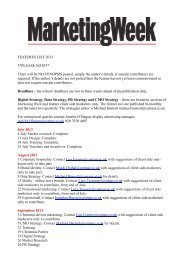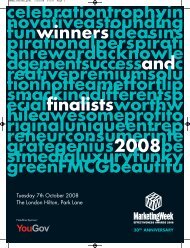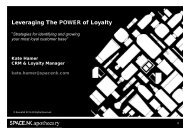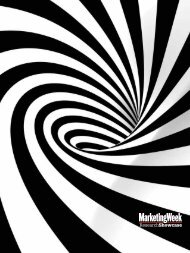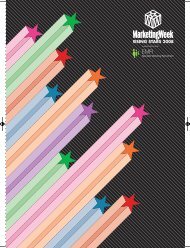Interactive Seven 2009 Supplement - Marketing Week
Interactive Seven 2009 Supplement - Marketing Week
Interactive Seven 2009 Supplement - Marketing Week
Create successful ePaper yourself
Turn your PDF publications into a flip-book with our unique Google optimized e-Paper software.
MWIB_260209_p041 19/2/09 17:48 Page 41<br />
INTERACTIVE USER-CENTRED DESIGN<br />
Style over substance? The Dior<br />
Homme website is popular,<br />
despite usability issues, because<br />
it demonstrates the brand’s<br />
products in an attractive way<br />
“Keep it simple.<br />
Get to know your<br />
consumer well...<br />
Provide them with<br />
content, tools and<br />
types of<br />
engagement that<br />
meet their needs<br />
and allow them to<br />
start a dialogue<br />
with you”<br />
Mo Rogers, AKQA<br />
tor of strategic services at AKQA. She says that ensuring greater usability<br />
means constantly thinking about the needs of end users and applying<br />
design techniques with that in mind. But it is easy to over-complicate<br />
the process. “Keep it simple. Get to know your consumer really well,<br />
understand what they are thinking and feeling about your brand. Provide<br />
them with content, tools and types of engagement that meet their<br />
needs and allow them to start a dialogue with you,” she says.<br />
She rates Apple and BBC for having clear, user-centred websites,<br />
which build on the brands’ strong design heritage: “The end result is<br />
well-structured, intuitive and highly usable.”<br />
However, others fail to achieve these high standards. “Fashion labels<br />
regularly commit every usability crime in the book: opening multiple<br />
browser windows; pure Flashbased,<br />
labyrinthine navigation;<br />
ultra high-resolution images which<br />
take forever to load; and no clear<br />
purpose to the experience, but just<br />
a set of images and MPEGs,”<br />
Rogers says. “Many packaged<br />
goods brands are also poor, particularly<br />
when the site ends up showing<br />
the most recent TV ad, perhaps<br />
just supported by a small game that<br />
serves little purpose except to tick<br />
the box of ‘interactivity’”.<br />
However, the Dior and Ralph<br />
Lauren sites do have their fans, as<br />
they offer a clear demonstration of<br />
the brands’ products. According to<br />
a survey by usability agency Webcredible,<br />
the best high street e-commerce<br />
sites are improving their<br />
ease of use every year. This year,<br />
the top 20 sites boosted their average usability score as measured by the<br />
agency to 67.8 from 57 last year. This highlights the retailers’ recognition<br />
of the importance of usability in winning sales in an increasingly<br />
competitive environment.<br />
The usability league of high street ecommerce sites is topped in the<br />
survey by WH Smith, rising from 17th place last year. Early Learning<br />
Centre’s site jumped to second place from eighth last year and Hamleys<br />
leapt up the league to share joint third with John Lewis and last year’s<br />
number one HMV.<br />
Use them or lose them<br />
Webcredible director Trenton Moss says the sites have addressed the<br />
basic barriers to usability. They have eliminated hidden delivery costs,<br />
ditched confusing check-out procedures and weeded out repeated error<br />
pages. He points to some of the usability problems that websites can face.<br />
For example, Norwich Union’s site commits a cardinal error. When users<br />
apply for car insurance, an error message appears if they leave a gap<br />
anywhere in their phone number, but they are not advised to join up the<br />
number. “A lot of users are lost at that point,” Moss says.<br />
He suggests that sites should use panels of potential users to spot any<br />
potential pitfalls. “You recruit ten people who are typical of the target<br />
audience and set them tasks on the site. You soon uncover anything that<br />
makes it difficult to complete those tasks and then you can make the<br />
improvements,” he explains. But he says this research needs to be carried<br />
out by a usability expert, rather than by an in-house web designer,<br />
or potential problems may be missed.<br />
Another method that can help in building usable websites is card<br />
sorting. Research respondents are given cards bearing the titles of all<br />
the various pages on the website and are asked to sort them into logical<br />
groups. This can form the basis of the site map and is indicative of how<br />
users naturally structure information.<br />
As the web gets even more complex, brands will need to ensure that<br />
they keep the needs of users at the forefront of their site designs. <br />
<strong>Marketing</strong> <strong>Week</strong> <strong>Interactive</strong> 41




